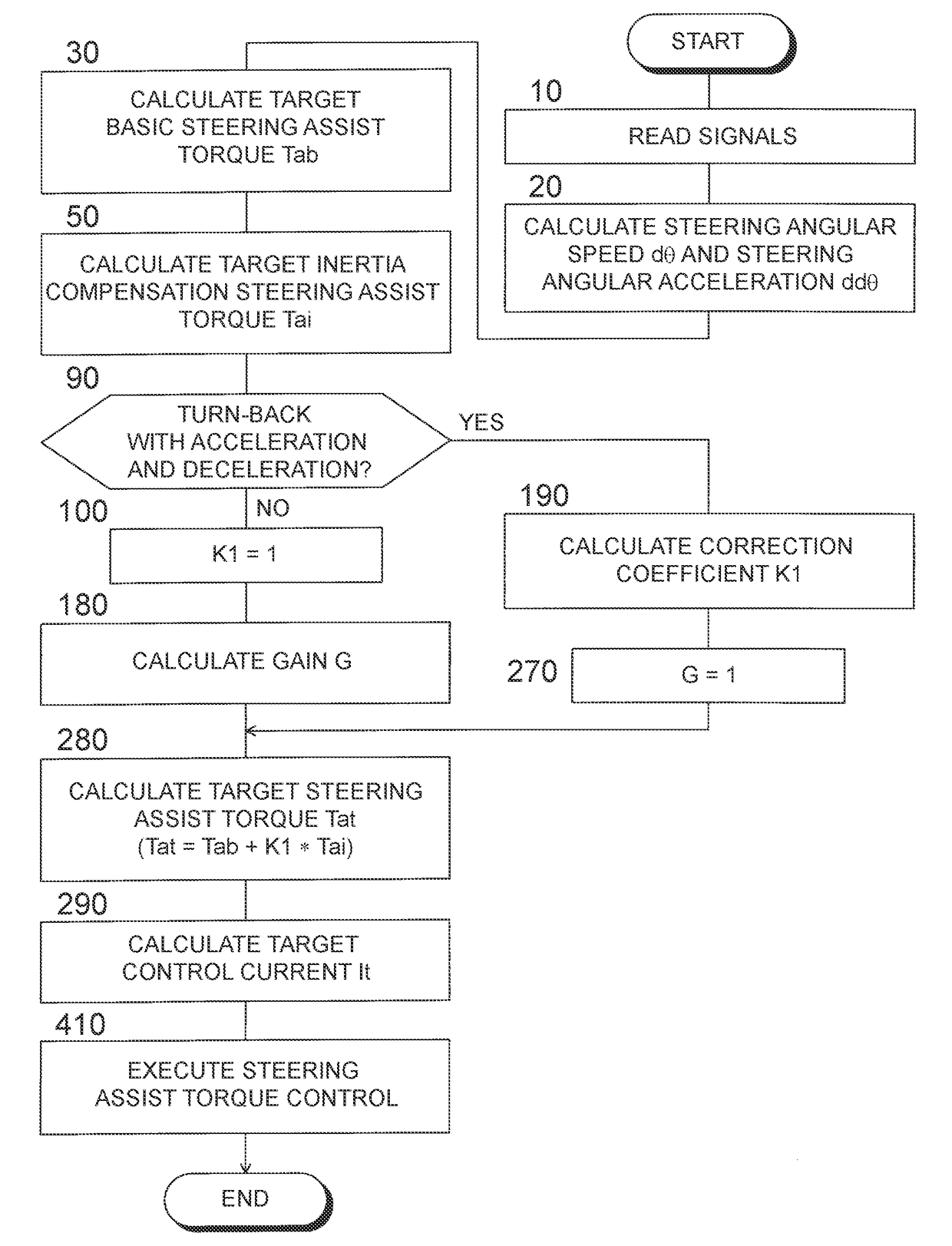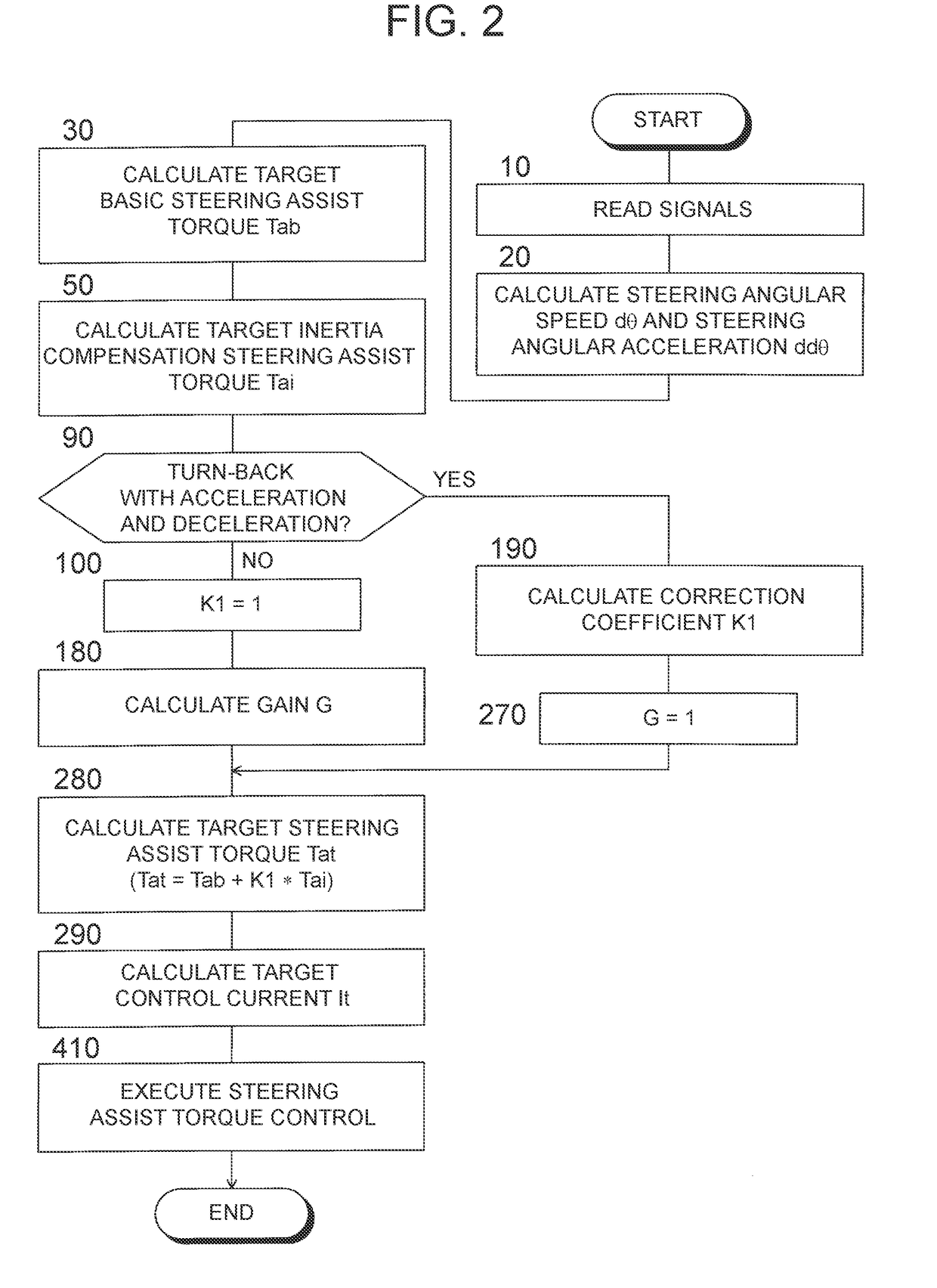Steering assist device
a technology of steering assist and torque, which is applied in the direction of electric steering, power steering, vehicle components, etc., can solve the problems of increasing the steering force necessary, steering overshoot, and deteriorating steering feeling in actuality, so as to prevent responsiveness in steering assist torque control, sufficient responsiveness, and gain feedback control
- Summary
- Abstract
- Description
- Claims
- Application Information
AI Technical Summary
Benefits of technology
Problems solved by technology
Method used
Image
Examples
first embodiment
[0082]In the first embodiment in particular, when it is determined that the steering operation of the driver is turn-back with acceleration and deceleration, the electronic control device 24 multiplies the target steering assist torque Tat by a correction coefficient K1, which is smaller than one, to calculate a corrected target steering assist torque Tat with its magnitude being reduced. The electronic control device 24 further calculates the target control current It based on the corrected target steering assist torque Tat.
[0083]The electronic control device 24 further performs feedback control of the control current supplied to the electric motor 48 based on the target control current It to control the steering assist torque so that the steering assist torque Ta coincides with the target steering assist torque Tat.
[0084]A description is now given of a steering assist torque control routine executed by the electronic control device 24 with reference to the flowchart illustrated in...
second embodiment
[0104] when it is determined in step 90 that the steering operation of the driver is turn-back with acceleration and deceleration, the magnitude of the correction amount ΔT2 is calculated based on the absolute value of the steering angular speed dθ in step 200. In step 300, the target steering assist torque Tat is calculated as a sum of the target basic steering assist torque Tab and the value Tai−ΔT2*signTab obtained by subtracting the product ΔT2*signTab from the target inertia compensation steering assist torque Tai. Furthermore, in steps 310 and 410, the electric power steering device 22 is controlled so that the steering assist torque Ta coincides with the target steering assist torque Tat.
[0105]Therefore, according to the second embodiment, as in the first embodiment, in the situation where turn-back is performed with acceleration and deceleration, decreasing the magnitude of the target inertia compensation assist torque makes it possible to decrease the magnitude of the curre...
third embodiment
[0112] in step 40, the basic steering assist torque control current Iab is calculated based on the target basic steering assist torque Tab, and in step 60, the inertia compensation control current Iai is calculated based on the target inertia compensation assist torque Tai.
[0113]When it is determined in step 90 that the steering operation of the driver is turn-back with acceleration and deceleration, the correction coefficient K3 is calculated based on the absolute value of the steering angular speed dθ in step 210, the correction coefficient K3 becoming smaller in the range of less than one and larger than zero as the absolute value of the steering angular speed dθ is larger.
[0114]In step 320, the target control current It is calculated as a sum of the basic steering assist torque control current lab and the inertia compensation control current Iai with its magnitude being corrected to be smaller with the correction coefficient K3. Furthermore, in step 410, the control current supp...
PUM
 Login to View More
Login to View More Abstract
Description
Claims
Application Information
 Login to View More
Login to View More - R&D
- Intellectual Property
- Life Sciences
- Materials
- Tech Scout
- Unparalleled Data Quality
- Higher Quality Content
- 60% Fewer Hallucinations
Browse by: Latest US Patents, China's latest patents, Technical Efficacy Thesaurus, Application Domain, Technology Topic, Popular Technical Reports.
© 2025 PatSnap. All rights reserved.Legal|Privacy policy|Modern Slavery Act Transparency Statement|Sitemap|About US| Contact US: help@patsnap.com



